Antique medicine bottles are old-school bottles that have the information needed to figure out the age of the bottle and the location of its production. These bottles are part of the historic factors that fueled the development of the glass field. They created a sort of competition between medicine manufacturers to produce very transparent bottles with contents to cure diseases. The surge to have the best medical bottle created a beautiful array of antique medicine bottles which are highly rated collectibles all over the world.
There’s no doubt about the intriguing charm of antique medicine bottles. These old medicine bottles have nice designs, cool shapes, and bright colors as compared with the new bottles used in this century. Seeing these vintage bottles around shows the changes that have occurred in the pharmaceutical world between the 18th century and now. The possibility of finding an antique medical bottle in different shapes and sizes currently is endless because there were several sick people then. The bottles from these sick people are in the collectors’ market for the sake of history and purchase.
It takes someone that has a lot of experience with these bottles to name them and figure out their value. Most people see these old bottles but never figure out what they are or how much they are worth. Are you curious about how to identify antique bottles? Or do you want to know the origin of these bottles? Or do you need to understand the value and price of antique medicine bottles? The answers to these questions are here as this article discusses the identification, valuation, and purchase of antique bottles.
Table of Contents
History of medicine bottles
Medicine bottles started coming into play during medieval Europe. Alchemists used them as baits to lure sick customers to their shops. The bottles usually held herbs, lotions, and potions. Antique medicine bottles were first manufactured on a large scale during the 18th century. These vintage bottles held medicine, were branded, and then sold commercially.
As more medicine manufacturers became known, the designs of medicine bottles got fancier and more interesting because everyone just wanted to have the best bottles. The glass industry workers did justice to making the bottles easy to use and evolved into making different shapes of medicine bottles. Eventually, the bottles started coming in diverse colors ranging from white to brown to blue and beyond.
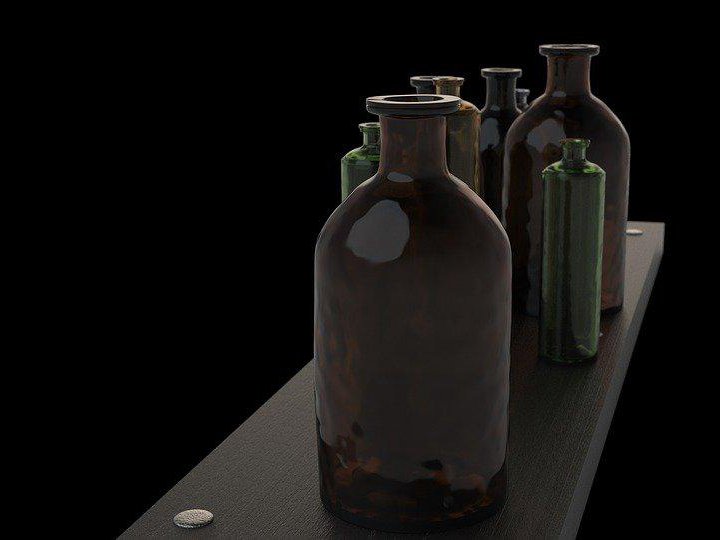
Later in the 19th century, the Big Sensation medicine company collaborated with Hamlin’s Wizard Oil of Chicago to put up shows to market their medicine. This was a major channel for the widespread use of medicine bottles at that time and people were fascinated by them.
Types Of Antique Medicine Bottles
Medicines back in the 18th century majorly consisted of natural herbs with a high concentration of alcohol. Most antique medicine bottles have lost their labels so the only way to recognize the diverse types is by their content. The type of antique bottle depends on what it contains. So, generally, there are four types of antique medical bottles based on their content.
Prescription medicine bottles
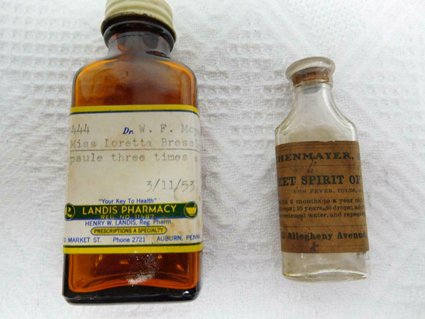
prescription bottles came from glass companies for local pharmacy stores. These bottles were useful for marketing the pharmacy store in communities. The bottles usually have the company’s name and address all over it.
Sarsaparilla medicine bottles
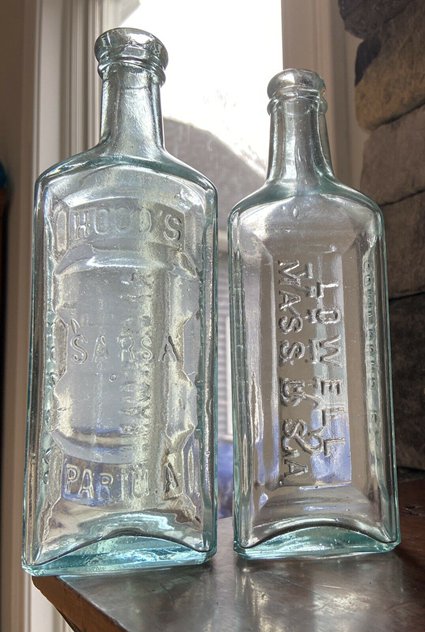
this medicine bottle contains a medical concoction that was widespread in the 19th and 20th centuries. The concoction is from a mixture of the root of the sarsaparilla plant and other herbs. This medicine bottle is similar and quite common too.
Cures and Remedies medicine bottles
some medicine manufacturers produced medicine bottles with inscriptions such as ‘cures’ or ‘remedies’ on them. These bottles are easily recognizable wherever you see them. However, they are very few now because the medicine that has this inscription is still outlawed in the United States under the Sherley amendment in 1912.
Bitters medicine bottle
These bottles were the most popular medicine bottles in the 19th and 20th centuries. They were popular because of their content. The Bitters came from mixing natural herbs with a lot of alcohol. These medicines were widespread because, during the movement, they allowed the legal consumption of alcohol.
How To Identify Antique Medicine Bottles
The first means of identification of antique bottles is based on its approximate or exact production date. A medicine bottle that is dated as far back as 100 years is an antique medicine bottle. So, any bottle produced after then is a vintage medicine bottle. After this, the next means of identification depends on the size, shape, and color. As earlier said, identifying an old medicine bottle can be overwhelming but with the features, you will see very soon that you can do that swiftly. The following are features that will help you in the identification of old medicine bottles in detail:
1. Branding and trademarks
The old medicine bottles from the early 1800s had indentations of logos, brand names, and product names. Some of them are marked with a description of the name and address of the drug store that produced the medicine. With the information of the brand, you can track the origin of the bottles and figure out the producer of the medicine.
If you’re lucky to find all the labels of the medicine, you can still trace its origin. Antique medicine bottles produced in 1850, especially in America made the glass mold side lettered. Bottles produced after then have their trademark information at the bottom of the bottle. Although most old glass medicine bottles are branded, some aren’t branded at all. So, this feature will be useless to trace its origin.
2. Design and shape of the bottle
The shape of the bottle can either be rectangular, cylindrical, or round. You should also check if it has an embossment with any description or has any sports panels or indentation. Most medicine bottles are usually thicker than the bottles used for water, beer, and liquor.
Another thing to note is those antique medicine bottles have a thin neck and mouth and a prominent rim. This design of the bottles gives access to the flow of the medicine from the bottles. It also limits the evaporation of the medicine from the bottle by allowing the fix of a cork.
The shapes of the medicine bottles made in the 18th century are rectangular, circular, or square. They usually have pointed bases and have imperfections such as small bubbles in the glass bottle. Medicine bottles made in the 19th century are mostly rectangular with lots of indents. These bottles were quite common at this time until another development came up in the 20th century.
3. Color
Initially, in the early 18th century, medicine bottles solely had an amber color to protect the content of the bottles from sunlight. They stopped producing these amber bottles in the late 18th century. In the late 18th and 19th centuries, manufacturers started making green bottles ranging from dark green to olive green.
Some even made dark bottles which are remarkably like the green and amber but of a darker shade. Fast forward to the 20th century, medicine bottles were clear and transparent instead of aqua or amber. They made the bottles clear and transparent to ensure that the content is visible.
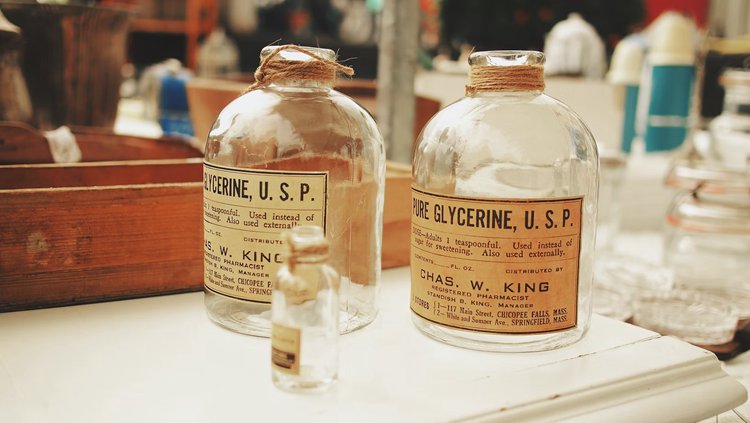
4. Bottle marking
As much as the color, design, shape, and branding of an old medicine glass bottle can tell you the origin and the age, the bottle marking is one feature that supplies these answers more accurately. The bottle markings are usually on the body of the bottle or at the base. Many bottles have markings that show the company’s initials or trademarks.
Some just have a number sequence. Antique medicine bottles that have these number sequences are hard to date because it is not easy to find major information about them. However, this doesn’t change the fact that these number sequences give accurate information about it.
Initially, bottle markings were on the bodies of the bottle but in the late 19th century they were at the base of the bottles. The one or two-digit marketing mold in the bottle at the base shows the specific number of the bottle and production date.
The numbers molded in the base of the bottle also show the type, shape, style, manufacturing date, and factory location dates. These bottle markings are by the glass producing companies to figure out when and where the medicine bottles were produced.
5. Visit an antique glass specialist
An antique glass specialist is one who is knowledgeable and resourceful about antique bottles and how to identify them. These specialists can give you all the information you need about an old medicine bottle, its origin, use, and its value.
Another source of information is an antique forum that consists of experts and newbies that have substantial information about identifying an antique medicine bottle. Either of these two categories helps to trace an old medicine bottle through life experiences.
6. Use a book or online resources
If you searched a standard library, you would find books and reference manuals with all information about diverse types of antique medicine bottles. These resources hold the history, origin, and value of several old medicine bottles.
One of the most popular books on antique medicine bottles is ‘The Bottle Book: A Comprehensive Guide to Historic Embossed Medicine Bottles’ by Richards Fike. If you don’t have access to a physical library, you can get several other books or you can use resources online too.
You can also use online websites to get information about the dating and origin of antique medicine bottles. Antique Bottles is a glass community and an online resource that has the manufacturer information for every bottle that you search for on it. It also has info on pricing and identifying marks.
Another online resource is Bottle Book. It has lots of pictures of various mold lines, machine markings, and pontil marks. It also supplies information about the manufacturer, age, and market value of various bottles.
The Value Of Antique Medicine Bottles
Most people think that all these old medicine bottles are valuable because they were made with quality materials and were sold for so much at the time they were produced. This isn’t a determinant of the worth and value of these bottles. An important fact is that most of these antique medicine bottles are very affordable, especially for people that want to collect them.
Most of them are worth between $10- $50 depending on the state of the bottle and some other factors. However, some very rare bottles can be sold for up to $8,000, such as the Rémy Martin Louis XIII Black Pearl, although this mainly applies to other kinds of glasses, not medicine bottles The value of these bottles needs to be known just for information’s sake and for collectors. Some people just buy them for their houses because they are an excellent display. The value and worth of these old medicine bottles depend on some factors which are as follows:
Manufacturer
The manufacturer of the medicine bottle is a major determinant of the value of the bottle. Notably, bottles used by brands that make bitters have a higher value than other medicine bottles. Brands such as:
- Fisch’s Bitters
- Kelly’s old cabin Bitters
- Warner Safe Bitters
- Drake’s Plantation Bitters
- National Bitters
Some manufacturers reproduce glass bottles, and the value of such bottles isn’t high. So, if you will be collecting antique bottles you should avoid such.
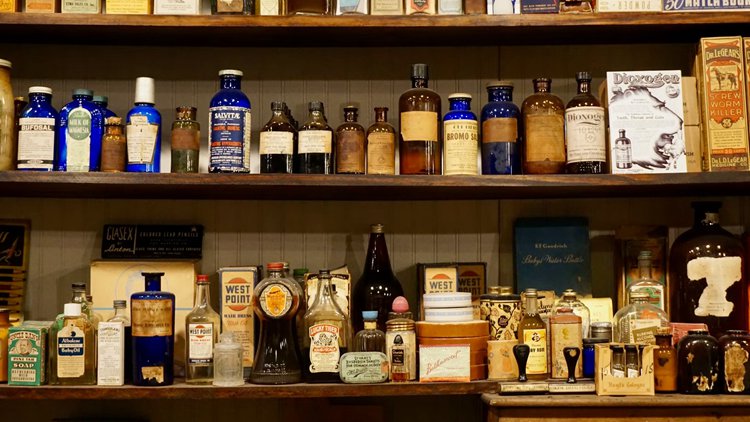
Condition of the bottle
For the value of a bottle to be high, it must be in exceptionally good condition. It is most likely very neat, clean, and minty as it was when it was produced. It mustn’t have any scratches, dents, chips, or maybe need repair. Bottles that have scratches, and cracks and need repair usually don’t have a high value and they are sold at a very low price, compared to the ones that are in good condition. The rating conditions range from ‘damaged’ to ‘mint’ condition.
Old medicine glass bottles that have holes have existed for so long and their value now is quite low. A bottle in good condition looks very impressive for purchase at any price given. But if there is a scratch or bubble in the bottle, no one would want to buy it at a remarkably high price.
Limited Availability
Medicine bottles that had limited availability then held so much value. Bottles that fall into this category are the ones produced in small quantities with so much potency and are extremely popular. Their popularity and limited availability made them awfully expensive at that time and now the value of the bottles is so high. The value and worth of these bottles are so high that they would be worth several thousand dollars if placed at auction.
Most of these bottles don’t take the same shape as regular medicine bottles. Some of them are made in the form of a log cabin (bottles of Drakes Plantation Bitters), or human figures (Recreation look of George Washington produced by Bernard Simeon of Scranton, Pennsylvania). Some were even made to look like corns (produced by national Bitters). These bottles were most sought after because of their shapes.
Color
Some antique glass specialists say that the color of a bottle can decide its worth. Although it isn’t a consistent fact, it turns out to be 50% true. For instance, according to some estimates, a colored glass bottle can be worth as much as $1,000 more than a clear bottle of the same shape and size. This works for bottles that have scarce colors. An example is a bottle that has a purple or pink color; the value of such a bottle would be remarkably high. Bottles in these colors are very scarce and when collectors lay their hands upon them it feels like they just got a hidden treasure.
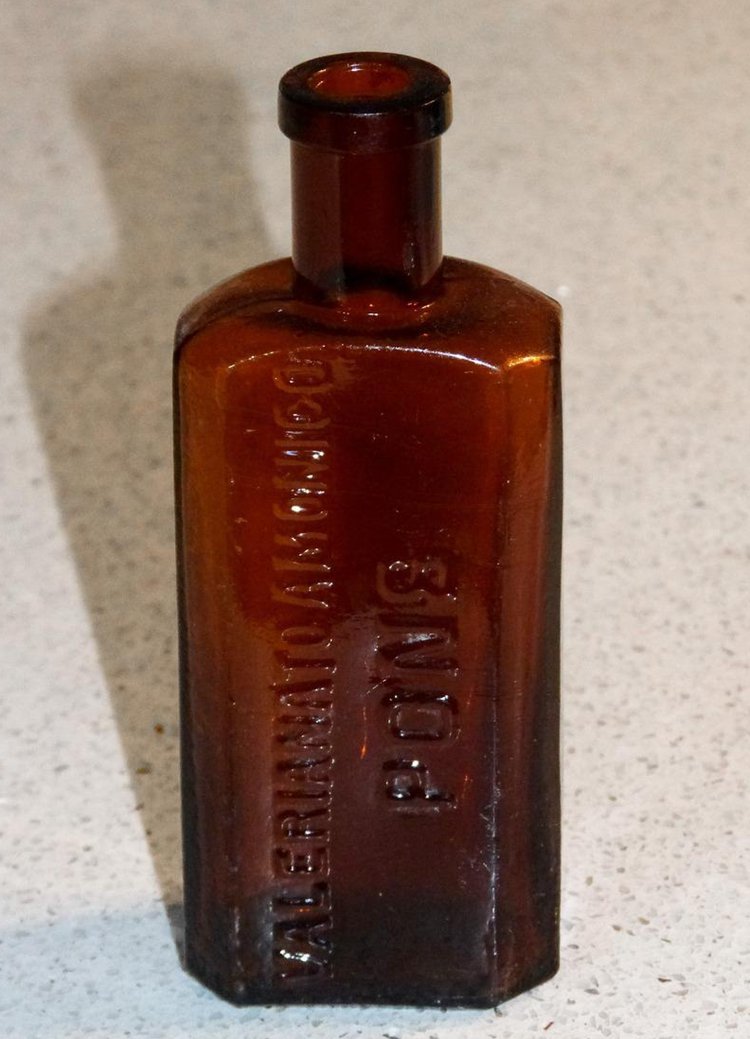
Experts of antique glasses concluded after so much research and gave a color guide. Medicine Bottles that have high value are usually those with shades of yellow, cobalt blue, puce, casein, and purple. Medicine bottles with medium value are olive green, black, teal blue, and milk in color. Lastly, the low-value bottles are usually clear, aqua or amber.
In rare cases, some of the bottles with colors that yield low value have another color they are combined with, or maybe they have nice designs. If these other cases are present, there’s a possibility that their values would be increased.
Labels and content
It isn’t common to find an antique medicine bottle with its label still intact. The Society for Historical Archeology lists some of these on its website. The presence of the label pushes the value of the bottle higher. The label shows the origin of the bottle and gives some valuable information about the bottle. The label has information about the manufacturer, the content, and the potency of the content of the bottle. Collectors value bottles that have labels and are willing to buy them at any price.
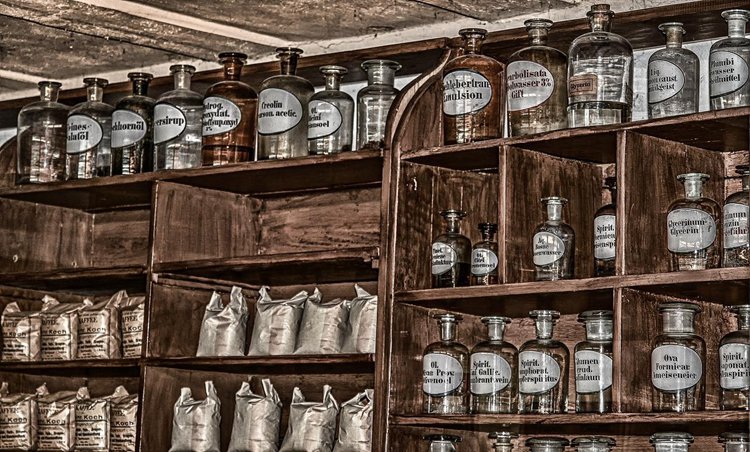
The value heightens again if by chance the bottle still has the contents of the medicine in it. This happens in rare cases, but it is very illegal and harmful. They are illegal because the medicine produced back then has narcotics. Narcotics aren’t used in the production of drugs nowadays because they are prohibited by DEA in the US.
Design of the Bottle
The exquisite design and shape of a bottle are known to attract a high value and worth. Especially medicine bottles that aren’t made in the stereotypical design of medicine bottles. These special-looking old medicine bottles seen today catch the attention of collectors and they are worth much.
How To Buy/collect An Antique Medicine Bottle
Before buying or collecting an antique medicine bottle you should do thorough research. Ensure you have all the information about the bottles you have in mind. This research is necessary to avoid buying a reproduction bottle. To be sure of the condition, origin, features, and authenticity go with sellers that have a good reputation and are open to questions. You can build your collection of old medicine bottles by buying from the following sources:
Online stores and websites
If you have an interest in buying an antique medicine bottle, there are sources or sites that you can get them from. You can get these bottles on eBay; an auction site with a search choice to help you scrutinize your search for the bottles. They have filters such as condition, price, and refinements to help to get the exact one you’re looking for.
There is another website called Etsy. Open one search of antique medicine bottles on it and it’d give a wide range of choices with excellent examples from all over the world. Since there’s a lot to choose from, you should ask questions to know what you’re going to get. Also, Collectors Weekly is a website that also gathers auctions on these old medicine bottles. This site goes into detail about each antique bottle and gives the necessary information that you need on each of the bottles.
Antique Stores
Professional antique dealers or specialists own antique stores. These stores have a diverse collection of antique bottles from different centuries. It is an excellent choice to build your collection through their sources because they have a lot of information about valuing and identifying antique medicine bottles. So, these stores would grant you a wide variety to choose from and you can be sure that you won’t get swindled.
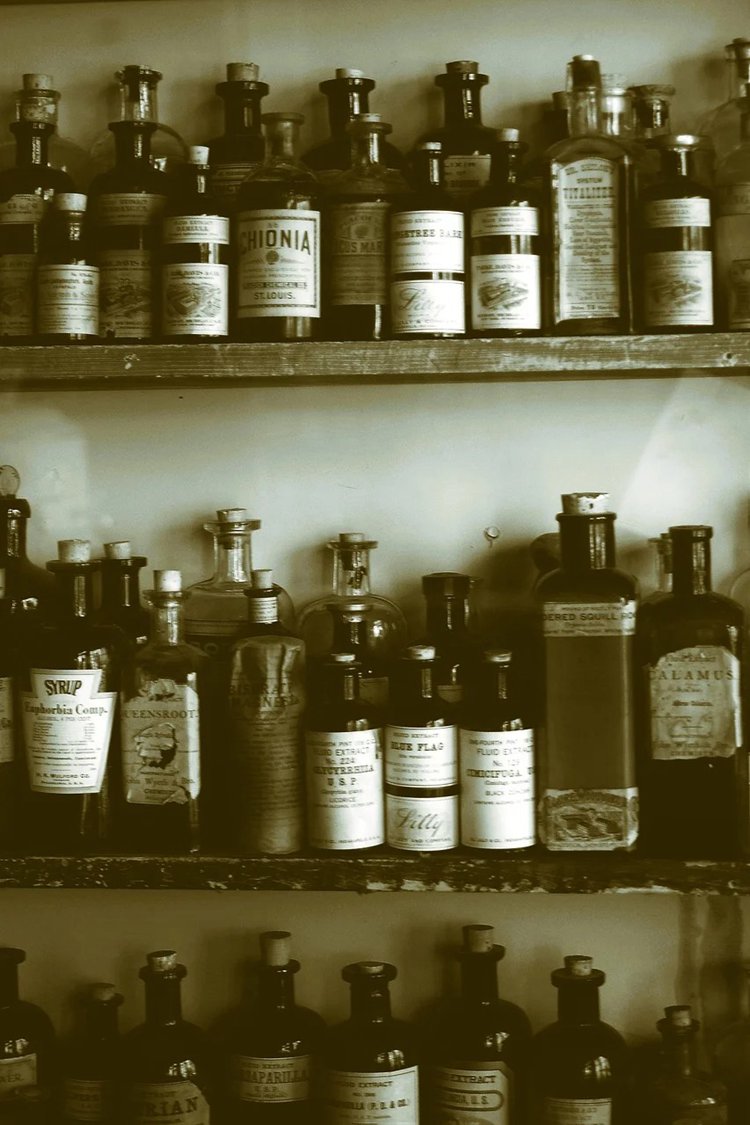
Auctions and Yard Sales
This is another spot to collect valuable old medicine glass bottles. Most people have these bottles passed down to them but don’t see any reason to keep them or to have them. So rather than store them, they put them out on sale to for ridiculous prices. Some of them that know the worth and value of these bottles put them in auction sales. So, the highest bidder buys the bottles. You can only pull this method of collection if you have done your research on the medicine bottles well enough.
Conclusion
You need to know the origin and value of these antique medicine bottles before collecting or buying them. And it’s not bad to just have this information even if you aren’t going to collect them. Most collections of old medicine bottles that people have used for interior design. The colors of the bottles sync into one bright look which makes them look so beautiful. You can hop on all the websites and stalls mentioned earlier to get your collection.






![Vintage Schwinn Bikes: [Types, Identification, and Values]](https://www.txantiquemall.com/wp-content/uploads/2022/05/5.-Schwinn-1967-Ramshorn-Fastback-Stingray-Sky-Blue-vtg-600x450.jpg)
